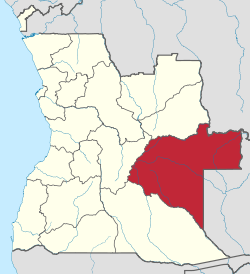Moxico Province
| Moxico | |
|---|---|
| Province | |
 Moxico, province of Angola | |
| Country | Angola |
| Capital | Luena |
| Government | |
| • Governor | João Ernesto dos Santos |
| Area | |
| • Total | 223,023 km2 (86,110 sq mi) |
| Population (2014 census) | |
| • Total | 727,594 |
| • Density | 3.3/km2 (8.4/sq mi) |
| Area code(s) | 254 |
| ISO 3166 code | AO-MOX |
| Website |
www |
Moxico (Portuguese spelling) or Moshiko (Bantu spelling) is the largest province of Angola. It has an area of 223,023 square kilometres (86,110 sq mi), and covers 18% of the landmass of Angola.[1] The province has a population of 727,594 (2014 census) and a population density of approximately 2.8 residents per km² (7.2/sq mi), making it one of the most sparsely populated areas of Angola. The population of the province is in flux; displaced residents have slowly returned to Moxico since the end of the Angolan Civil War in 2002.[1][2] The war left Moxico as one of the most landmine-contaminated places in the world.[3] The governor of the province is João Ernesto dos Santos.[4]
Luena is the capital of the Moxico Province, and is located 1,314 kilometres (816 mi) from the Angolan capitol of Luanda.[2]
History
Moxico Province was the scene of much guerrilla fighting during the Angolan Civil War. Its long border with Zambia at the east of the province was a base of operations for UNITA and MPLA. As a result, Moxico Province saw many raids by the military of South Africa.[5]
Moxico Province is known as the place where UNITA rebel leader Jonas Savimbi was killed in 2002, signalling an end to over a quarter-century civil war in Angola. Savimbi's body was buried in the village of Lucusse, about 1,000 kilometres (620 mi) south-east of the capital, Luanda, under a tree near where he was killed.[6]
Geography
Moxico Province borders Lunda Sul Province to the north, Bié Province to the west, Cuando Cubango Province to the south, the nation of Zambia to the east, and the Democratic Republic of the Congo to the northeast.
Municipalities
Municipalities of Moxico include:
Moxico is also home to Cameia National Park in the Cameia municipality.
Demographics
Moxico Province's is composed of a diversity of ethnic groups, and is primarily a Bantu area. Populations of Chokwe, Lovale, Mbunda, Lucazi, and Ovimbundu make up the majority of the province. Isolated communities of other ethnic groups exist throughout Moxico.[2]
Chokwe language is the most commonly spoken language in the province.[1]
References
- 1 2 3 "Moxico" (in Portuguese). Luanda, Angola: Info-Angola. 2014. Retrieved 2014-05-12.
- 1 2 3 "Perfil da Província" (in Portuguese). Lueno, Angola?: Portal do Governo Provincial do Moxico. 2011. Retrieved 2014-05-12.
- ↑ Angola profile, Mines Advisory Group
- ↑ "Moxico governor visits social projects in Luau". Luanda, Angola: ANGOP - Angola Press News Agency. 2014. Retrieved 2014-05-20.
- ↑ Broadhead, Susan (1992). Historical dictionary of Angola. Metuchen, N.J: Scarecrow Press. p. 140. ISBN 9780810825321.
- ↑ Savimbi 'died with gun in hand, BBC News
External links
- Official website of province governor
- Information on this province at the Angolan ministry for territorial administration
- Information on this province at Info Angola
- Angolan embassy in London on Moxico province
- Province geographical info at geoview.info
Coordinates: 12°S 20°E / 12°S 20°E